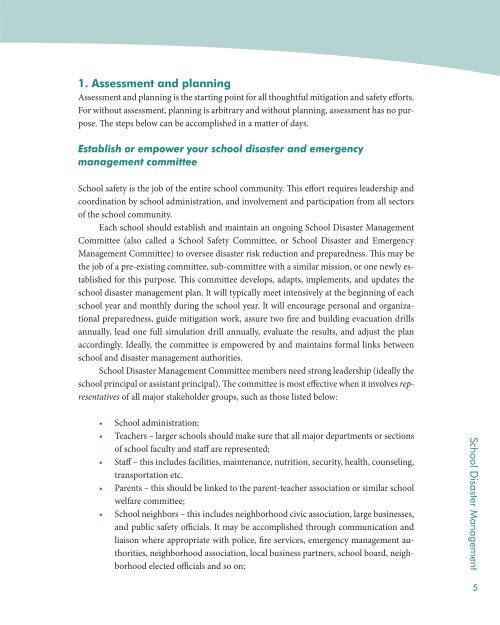Disaster and Emergency Preparedness: Guidance for ... - INEE Toolkit
Disaster and Emergency Preparedness: Guidance for ... - INEE Toolkit
Disaster and Emergency Preparedness: Guidance for ... - INEE Toolkit
Create successful ePaper yourself
Turn your PDF publications into a flip-book with our unique Google optimized e-Paper software.
1. Assessment <strong>and</strong> planningAssessment <strong>and</strong> planning is the starting point <strong>for</strong> all thoughtful mitigation <strong>and</strong> safety ef<strong>for</strong>ts.For without assessment, planning is arbitrary <strong>and</strong> without planning, assessment has no purpose.The steps below can be accomplished in a matter of days.Establish or empower your school disaster <strong>and</strong> emergencymanagement committeeSchool safety is the job of the entire school community. This ef<strong>for</strong>t requires leadership <strong>and</strong>coordination by school administration, <strong>and</strong> involvement <strong>and</strong> participation from all sectorsof the school community.Each school should establish <strong>and</strong> maintain an ongoing School <strong>Disaster</strong> ManagementCommittee (also called a School Safety Committee, or School <strong>Disaster</strong> <strong>and</strong> <strong>Emergency</strong>Management Committee) to oversee disaster risk reduction <strong>and</strong> preparedness. This may bethe job of a pre-existing committee, sub-committee with a similar mission, or one newly established<strong>for</strong> this purpose. This committee develops, adapts, implements, <strong>and</strong> updates theschool disaster management plan. It will typically meet intensively at the beginning of eachschool year <strong>and</strong> monthly during the school year. It will encourage personal <strong>and</strong> organizationalpreparedness, guide mitigation work, assure two fire <strong>and</strong> building evacuation drillsannually, lead one full simulation drill annually, evaluate the results, <strong>and</strong> adjust the planaccordingly. Ideally, the committee is empowered by <strong>and</strong> maintains <strong>for</strong>mal links betweenschool <strong>and</strong> disaster management authorities.School <strong>Disaster</strong> Management Committee members need strong leadership (ideally theschool principal or assistant principal). The committee is most effective when it involves representativesof all major stakeholder groups, such as those listed below:School administration;Teachers – larger schools should make sure that all major departments or sectionsof school faculty <strong>and</strong> staff are represented;Staff – this includes facilities, maintenance, nutrition, security, health, counseling,transportation etc.Parents – this should be linked to the parent-teacher association or similar schoolwelfare committee;School neighbors – this includes neighborhood civic association, large businesses,<strong>and</strong> public safety officials. It may be accomplished through communication <strong>and</strong>liaison where appropriate with police, fire services, emergency management authorities,neighborhood association, local business partners, school board, neighborhoodelected officials <strong>and</strong> so on;School <strong>Disaster</strong> Management5
















